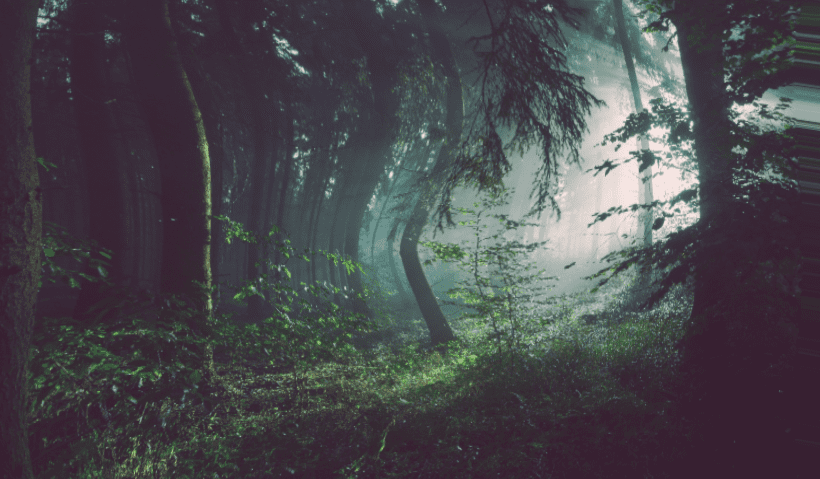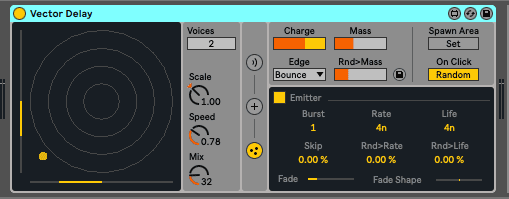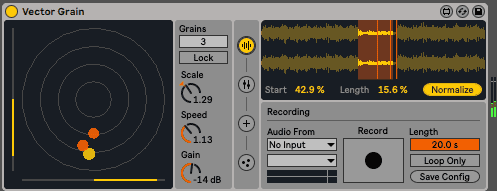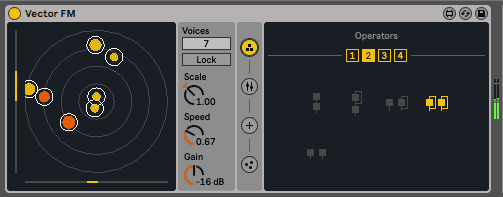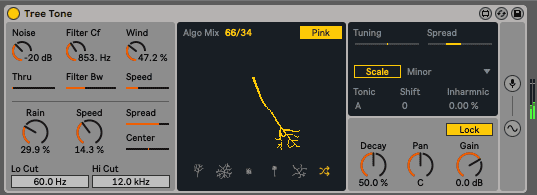We let nature inspire our creativity by delving deep into Live 11’s new Max For Live Inspired By Nature devices.
For most of its history, synthesis has been concerned with recreating the sounds of acoustic instruments. Look at a list of factory patches on a classic synthesizer like the Roland Juno-106 or Sequential Circuits Prophet 5 and you’ll see things like violin, piano and tuba. There’s nothing wrong with that but for our money, things started to get interesting when synthesis turned towards creating sounds that had never been heard before.
Lately, thanks to recent advances in computing, more out there forms of synthesis have been becoming more widely available. Think Eventide and Newfangled Audio’s Generate, which models chaos, and now a new suite of Max For Live devices that come bundled with Live 11, Inspired by Nature.
The six bonkers devices in Inspired By Nature use things like gravity, magnetism, and organic growth along with granular synthesis, frequency modulation, and more to generate or process sound. Highly experimental, they’re not the kinds of devices you’d reach for if you want to write a nice piano melody but if you’re looking for some creative inspiration or left-field sound design, they’re just the ticket.
We’ll use the six devices to put together an experimental techno track, building up drone layers, processing sound, and even setting up a generative melody. Where possible, we’ve constrained each device to the scale of A minor to make sure everything stays in key – a good way to keep things from getting too out of control.
Here’s the end result:
Vector Delay
Let’s start with the single effect device, Vector Delay. Inspired By Nature contains three vector devices, all of which use a particle system to manipulate and create sounds. Each particle’s movement is influenced by gravity as well as magnetism between each particle (or voice).
We start by programming some off-beat hats and then dropping Vector Delay onto the audio channel. Each particle in the device is a delay line. With up to 16 lines possible, things can get pretty wild. We don’t want to overdo it so we go with two voices. There will be plenty of other opportunities to experiment throughout this exercise.
Next to the main screen, there are three controls, Scale, Speed and Mix. We turn the Mix down to 32 as we want it to be on the subtle side. We want something that works with the rhythm, so we play around with the speed of the moving particles and go with 0.78.
Clicking the icon with the two sound waves reveals a filter, among other things. We set it to a lowpass Ladder filter and bring down the Cutoff just a little.
The bottom icon with three dots gives us control over the physics. We play around with the amount of particle Charge and the Mass. Engaging the Emitter changes the particles’ movement from smooth to momentary, which sounds better in a rhythmic context.
Top Tip: These are highly experimental devices to keep trying different things until you find something you like. Sometimes even small adjustments can have big, unexpected changes.
Here’s our hats with Vector Delay creating unusual echoes.
Vector Grain
The next vector device we’ll look at is Vector Grain. As the name suggests, this is a granular instrument, with each particle representing a sample grain.
We start by dropping in the sample ‘Teleharmonic_Drones_01.wav’ from the Samples From Mars pack, Modular Creations. We’re going to use it to create a sound bed.
We create three grains so we can have multiple playback heads running along the same audio file. We adjust the speed to 1.13 and also up the Scale a bit. By pulling on the bars along the X and Y axes, we can set the range of the particles’ movement. This also affects panning. The original file is a little full so we use the Ladder highpass to isolate just the highs.
We can see on the audio file that there’s a quiet part in the middle of the file. This is perfect for a background bed so we drag the loop start and end points to focus on this area.
Lastly, we send some of the channel to the stock Live Reverb and Delay to smooth things out.
Top Tip: Sample audio directly from a sound source instead of dragging in one.
Vector FM
The last vector device is Vector FM. This one uses frequency modulation together with particles to create some very unique (and unpredictable!) tones.
Let’s use seven voices and two operators per voice. We choose an operator that sounds not so chaotic and then turn the particle Speed down to give us a nice, modulating drone. Remember, this is more of a noise machine than your usual DX7-style FM synth.
In the filter section, we choose the lowpass-highpass Ladder and bring down the Cuttoff a touch to take the edge off.
Finally, we add some Reverb and Delay to bring it all together.
Top Tip: It can be difficult to control Vector FM so try routing it to a separate audio channel and recording the output. Then you can go back and cut out the best bits and use them in Simpler, or resample it for even crazier results.
Emit
Emit is a granular synthesizer that also uses particles, but instead of bouncing them around, it shoots them across a horizontal field. The device has two Emitters, or playback engines, meaning you can create some fascinating soundscapes.
We start by dropping in the sample ‘DarkModular_Drones_01.wav’ from the same Samples From Mars pack. Draw a window for each Emitter over a spectral representation of the sample. The window affects playback duration as well as frequency of each grain.
Each Emitter has two main sections, Emit and Grain. In the Emit section, you can choose how many grains there are, Force and Friction, The Grain section has controls for Glide, Blur and Pitch. Again, experimentation yields rewards.
Again, Reverb and Delay complete the sound.
Tree Tone
Tree Tone is a resonator instrument that uses the fractal growing patterns of trees as a model to create its sound. Downward-growing branches have lower tones while those reaching upwards are less so. You can use the various noise controls to excite the resonators, like wind blowing through the trees.
We’ve chosen a low branch and given it plenty of Wind to excite it. We’ve also dialed in some Rain, which creates tinkly resonant delays. We’ve also pushed the sound out into the stereo spectrum with the Spread controls.
Again, some Reverb on the send channel adds the finishing touch.
Top Tip: If you’re unsatisfied with your branch, click the window to ‘regrow’ it.
Bouncy Notes
The last Inspired By Nature device is Bouncy Notes, a MIDI device that sits before an instrument on the MIDI channel. We’ve paired it with Tension, Live’s physical modelling synthesizer.
Bouncy Balls unsurprisingly uses the physics of bouncing balls to randomly play MIDI notes. Play notes to drop balls onto the onscreen keyboard. You can affect the speed, gravity, and mass of the balls, as well the amount of friction (how likely it is to ‘scrape’ against a single note). There are a number of other parameters as well, like note length, velocity, and quantize.
We started by restricting the notes to two octaves of the A minor scale. We also adjusted the bars along the top and side of the window to affect the probability that the balls would strike fairly often.
Here are all the Inspired By Nature devices on one track.
